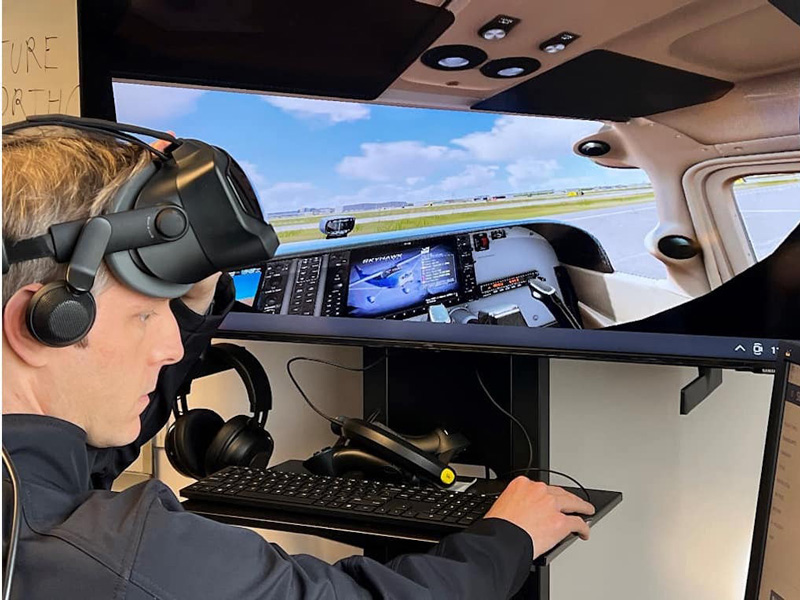
A group of 58 flight students at Embry-Riddle Aeronautical University were able to reduce the time it took them to complete a first solo flight by more than 30%, thanks to a new general aviation flight training program.
While results remain preliminary, reports from instructor pilots have been positive, said Dr. Ken Byrnes, chair of the Flight Department at Embry-Riddle’s Daytona Beach, Florida, campus.
“Students who go through our new training program are better prepared when they step into an airplane,” Byrnes reported. “They also have lower anxiety and greater confidence due to their experience and understanding of what to expect in the aircraft.”
The PILOT (Pre-flight Immersion Laboratory for Operations Training) program was launched by Embry-Riddle in fall 2021.
Embry-Riddle Flight Training Manager Nicole Hester agreed that the program is paying off.
“We have had students who finished and soloed in times that we have never seen before,” Hester said. “We’re also getting feedback from our instructor pilots that students in the new program can immediately control the airplane and understand radio communications very well.”
The idea of the new program was to “increase capacity by increasing efficiency,” said Dr. Alan Stolzer, dean of the school’s College of Aviation at Daytona Beach. “We also wanted to enhance student learning, improve aviation safety and help industry address a critical shortage of qualified pilots.”
VR Tools
In the program, flight students spend their first four weeks learning preflight, checklist, and flight procedures in virtual reality (VR) environments developed by Embry-Riddle and its industry partners.
“We believe that this is the first use of these VR technologies for general aviation training,” Byrnes said.
Using Embry-Riddle’s customized VR platforms, students practice tasks ranging from aircraft checklists and preflight inspection, to takeoffs and landings, flight maneuvers, and radio communications with Air Traffic Control (ATC). Students learn the basics of flight maneuvers through a VR flight trainer from True Course Simulations.
The VR software helps students leverage what they learned during simulator and oral activities by focusing on a three-step learning process – read, watch, and do, university officials note.
First, the student will read a short pre-flight briefing that gives them the essence of the material they need to know before each flight lesson. As a second step, the student will watch a video with the maneuver or task being performed. In this way, they get a visual on the objective, along with supplemental information on the maneuver or task itself. Third, students put all of their knowledge together in a high-resolution, interactive simulation. The simulation allows them to fly, applying everything they’ve learned until they gain mastery.
Another technology called CAART (Commercial Aviation Augmented Reality Toolkit), developed with Cole Engineering Solutions of Orlando, Florida, lets students learn checklists, as well as the aircraft walk-around process, and sit in a virtual Cessna 172 training aircraft on a simulated Embry-Riddle flight ramp.
“We can make about 50 things go wrong with the aircraft as the student completes the virtual pre-flight inspection,” said Robert L. Thomas, assistant professor of Aeronautical Science. “That is an extremely useful learning experience because in the real world, our aircraft are serviced with a goal to prevent any problems.”
Embry-Riddle’s PILOT program also features a virtual Air Traffic Control (ATC) lab. There, students ride along with a 360° video of a flight with a virtual instructor. The instructor introduces students to a variety of flight scenarios in complex environments such as a busy arrival to Daytona Beach International Airport. Throughout the video flight, the instructor explains what’s being said over the radio and how that corresponds to actions the student must take.
On real-world flights, instructors have little time to stop and review what’s happening via radio communications, step-by-step, explained ATC course designer and Aviation English Coordinator Andrew Schneider. In the simulation, students can listen without distraction to radio communications between the instructor and ATC, learning phraseology and developing listening fluency.
Students can then practice talking on the radio in another VR trainer. The Pilot Phraseology Trainer (PPT) helps students practice radio calls at their own pace, focusing on repetitive listening and speaking accuracy with simulated ATC.
In the final stage of radio training, students enter a VR flight so that they can test their skills in a simulated environment for realistic ATC training (SERA technology, developed by ATSi). As they speak with ATC, the SERA system uses artificial intelligence software to react to what the student pilot is saying as their flight progresses, correcting them when they make mistakes.
After four weeks of virtual training, Byrnes said, “Students go to the airplane and fly every day, whereas traditionally they wouldn’t fly that often. We’ve given them all the information they need, all the tools and practice, to start applying new skills in an actual airplane environment before they ever get there.”
